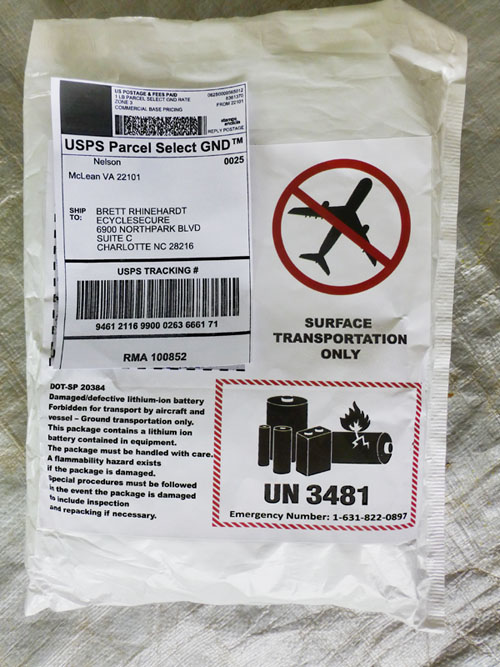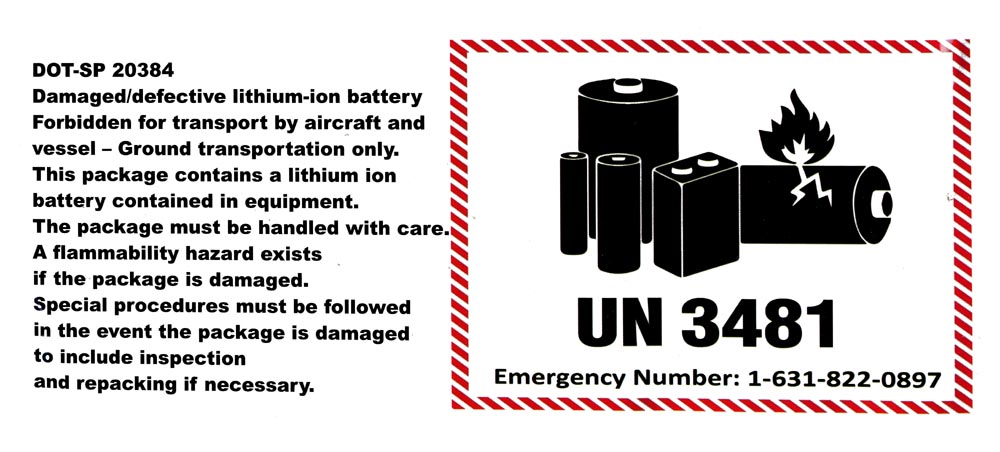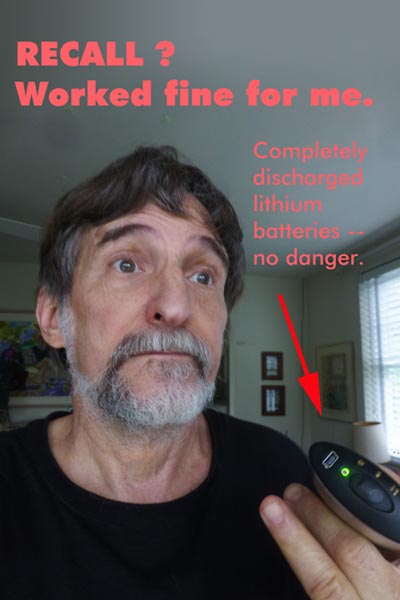bottom & links
SHIPPING OR FLYING WITH LITHIUM BATTERIES
especially the rechargeable ones
Two out of 12,000 EnergyFlux external
batteries-and-hand-warmers caught fire, so all (with that particular
battery) were recalled. They sent us special lithium battery envelopes.

Here's the label if you want one for your box.

UN 3481 is an electronic device with "batteries included," either packed with the device or built into it.
UN 3491: ditto, but lithium metal batteries, not lithium ion (aka lithium polymer) batteries. Lithium metal means cylindrical cells or button cells.
UN 3480/3490: A battery-only shipment, either lithium ion (-80) or
metal (-90). If you mix the two kinds, you can put both UN numbers on
the label.
"UN" is "United Nations" -- for global regulations, who you gonna call?
The phone number is yours -- "a person knowledgeable about the
shipment," not a first-responder, not someone able to answer for more
than the usual business hours.
Fewer than 4 rechargeable lithium-ion cells or only one lithium-ion
battery in a shipment does not require this label. I got this label
only once when I bought three lithium cellphone replacement batteries
at once.
The maximum rechargeable ("lithium-ion" or "lithium polymer") battery
shipment, shipped with or without the device they power, and with this
label, is
- 8 cells max, each 20Wh max, or
- 2 batteries max, each 100Wh max
- max 5 lbs/pkg max
Ordinary batteries' current can make
a toaster/hair dryer red hot, but they themselves do not burn.
Lithium, like the metals sodium and magnesium, does burn. USPS
lithium battery regulations are here: https://pe.usps.com/text/pub52/pub52c3_027.htm#ep900090
Other forbidden substances are covered here: https://pe.usps.com/text/pub52/pub52c3_026.htm#ep900056
Airplanes are another story: no loose, spare lithium batteries in checked baggage,
period -- have pity on the airlines, fires are awful for them, and,
down in the cargo hold, no one will notice in time.
Your in-cabin devices can have 100Wh
of lithium-ion batteries installed, and 20Wh of "metal" cylindrical
cells. Notebook/tablet/smartphones are all under the 100 Watt-hour
(W-h) limit, although Apple wishes they could build a MacBook Pro with
more battery power than that.
My old (2008) MacBook Pro is 12.75oz = 362gm for 50Watt-hours.
Turning from "lithium-ion" batteries to
"metal" cylindrical cells, the limit of 20 W-h is approximately one
large "C" cell. For less powerful NiMH chemistry, 20 Wh
would get you an
even larger D-cell at 2.5V x 8000mAh. New NiMH D's are rated
10,000mAh, you get 9,000 for a while and then they are 8000 for
years. 20Wh also gets you four NiMH AA cells at 2000mAh.
Watts are amps times volts, so 2,000 mill-amp hours (or 2 amp-hours) x
2.5V is 5 Watt-hours, and it takes four of them to reach 20.
The regulations for non-rechargeable lithium cells/batteries are
written in terms of grams of metallic Lithium per cell . . . as if
battery technology never changed, as if no battery manufacturer ever
heard of nanotechnology.
What about spares for in-cabin, accompanied baggage? If each
Li-ion
(aka Lithium polymer) battery is under 100Wh, you can take an unlimited
number of spares because anyone could smother a little fire in a little
battery. For the 100 - 160Why "extended life" battery packs
sold for notebooks and used in pro audio-visual equipment, two spares
are allowed. Airlines get confused, and limit all external Li-ion
battery packs to two spares per customer carry-on.
For any extra battery in carry-on,
- tape terminals and put each one in a plastic bag
- tuck it in somewhere, don't leave it to rattle around loose
- offer to show it to staff at check in
DISCHARGED?
No, rechargeable lithium batteries are always shipped charged.
Nobody
dead-shorts a lithium battery with a piece of wire, and all electronic
devices don't take batteries down to dead-flat either. Devices
turn off before their batteries lose voltage completely, otherwise the
plates (electrodes, anode/cathode) get damaged and life is
shortened. But we were told to
discharge our defective EnergyFlux battery before mailing in the
recall, since they were going to be thrown out anyway. So all of
these
labels are a waste of time, not counting the Idiot Factor . . .
(someone who mails but did not discharge first).
VOLKSWAGEN'S NIGHTMARE: Truth in Lending Clause: there is one
computer-controlled electronic device which runs the battery down to
dead flat if you leave it turned on: our new (2017 ) VW Golf
Alltrack. Some programmer forgot to add the shut-off at
10-point-something volts to the firmware. We never wanted to
trade in our old VW, but it had firmware that was just a little too
perfect. The firmware detected whether the car was going through vehicle emissions tests
(and always passed) or whether you were on the open road (when it
jazzed the engine for maximum performance at maximum pollution
generation). What a car! We passed every test, and
got 50 mpg highway. VW has paid $14.7 billion to replace all the
cars like ours, $30 billion overall.
Guess VW missed the detail about never completely discharging a
rechargeable battery. It's hard to worry about destroying your
customer's car battery when you are so busy destroying your own
company.

Use back arrow on your browser to return to exactly where you were, or go to:
Simple Postage Tables - the Parcel Post section
top of entire postage page
home for this website, such as it is.
If you ship batteries or travel and learn something useful,
take a moment to share it -- jerry_postage@nelsonic.org
Regards,
--jerry
--end
Rev 31May2018
Rev 30Jun2018 typos, define Wh=Ah*V, dead short explanation, VW's error


